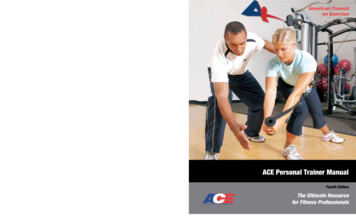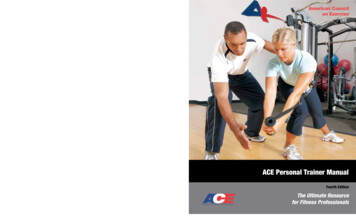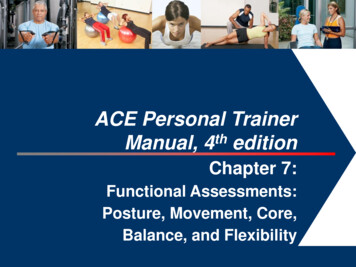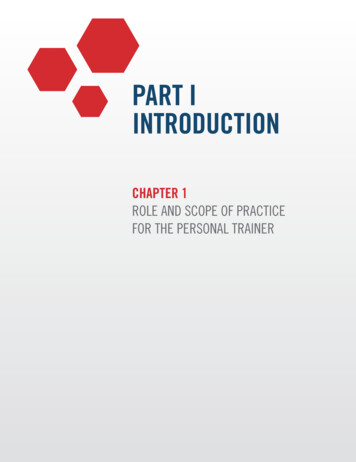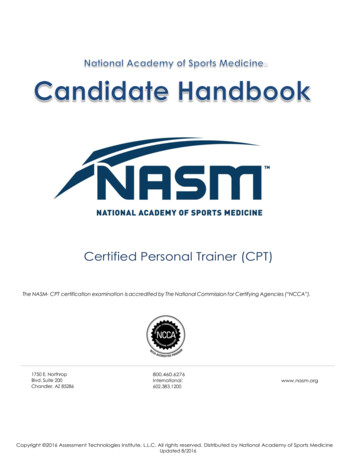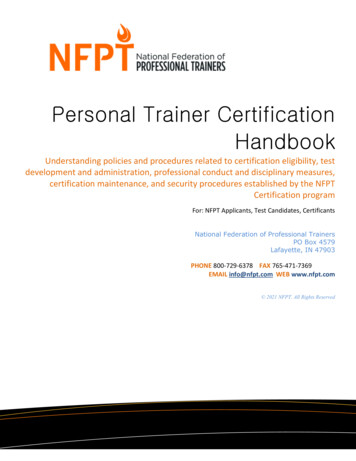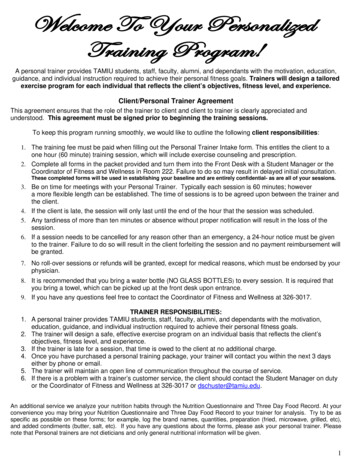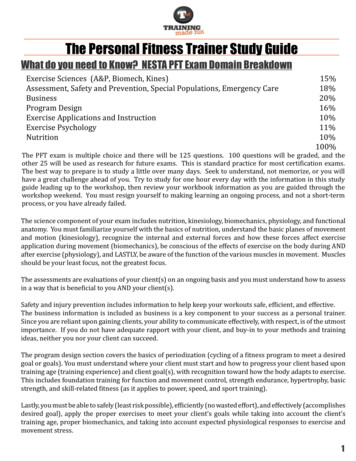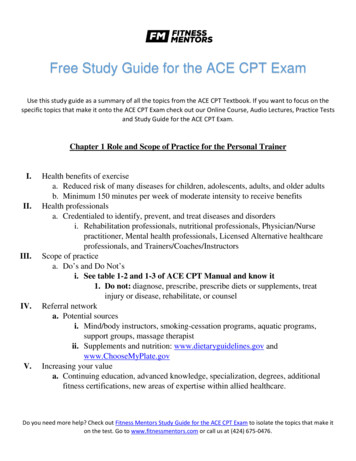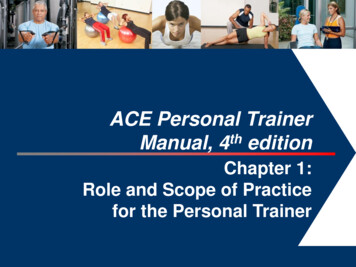
Transcription
ACE Personal TrainerManual, 4th editionChapter 1:Role and Scope of Practicefor the Personal Trainer1
Learning Objectives Based on Chapter 1 of the ACE Personal Trainer Manual, 4thed., this session introduces the role of the ACE-certifiedPersonal Trainer within the healthcare community andprovides guidelines for staying within the defined scope ofpractice. After completing this session, you will have a betterunderstanding of:– The knowledge, skills, and abilities associated with being a successfulpersonal trainer– The ACE Code of Ethics– ACE’s Professional Practices and Disciplinary Procedures– How the ACE certification has received recognition from the fitness andhealth industry, the education community, and the department of labor– The importance of a career-development plan
Introduction The human body responds to the stress of physicalmovement with improved fitness and health. 2008 Physical Activity Guidelines for Americans (U.S.Department of Health & Human Services)– Regular physical activity reduces the risk of many adverse health outcomes.– For most health outcomes, additional benefits occur as the amount of physicalactivity increases.– Most health benefits occur with at least 150 minutes a week of moderateintensity physical activity, such as brisk walking.– Both aerobic and muscle-strengthening activity are beneficial.– Health benefits occur across all population groups.– The health benefits of physical activity occur for people with disabilities.– The benefits of physical activity far outweigh the possibility of adverse outcomes.
Fitness Professionals Help Clients Improve Health Physicians generally do not provide specific instructionsfor how to exercise. ACE-certified Personal Trainers play a vital role in alliedhealthcare.– They help clients achieve positive health and fitnessimprovements. Combating rising levels of obesity and diseases relatedto lifestyle choices has led to a positive outlook forpersonal training as a profession.
The Allied Healthcare Continuum The allied healthcare continuum is composed of healthprofessionals who are credentialed through:– Certifications– Registrations– Licensure Physicians are at the top of the alliedhealthcare pyramid, evaluating patients todiagnose ailments and implement treatmentplans, or referring patients to specialists asneeded.
The Role of Fitness Professionals The role of fitness professionals in relation to the othermembers of the healthcare team is presented on the followingslide. The personal trainer should obtain written permission from theclient to communicate with the referring physician. Even when clients do not have a physician’s referral, it isimportant for the personal trainer to maintain confidentialrecords that include the client’s:– Program– Progress– Health-history information
Specialty Areas Within Allied Healthcare
The ACE Personal Trainer Certification Candidates must meet or surpass a level of “minimumcompetency” as assessed by a competency-basedevaluation (exam) to show that they are adequatelyqualified to work in the profession. The primary purpose of a certification is to protect thepublic from harm. An ACE-certified Personal Trainer has provencompetence in:– Making safe and effective exercise-programmingin a variety of practical situations– Minimizing client risk and exposure to harmdecisions
Defining “Scope of Practice” A scope of practice defines the:– Legal range of services that professionals in a given field canprovide– Settings in which those services can be provided– Guidelines or parameters that must be followed The laws, rules, and regulations that govern a professionare established for the protection of the public. Fitness professionals as a collective group have ageneral scope of practice, as presented on the followingslide.
General Scope of PracticeFitness Professionals DONOT:Fitness Professionals DO:Diagnose Receive exercise, health, or nutrition guidelines from a physician, physical therapist, registereddietician, etc. Follow national consensus guidelines for exercise programs for medical disorders Screen for exercise limitations Identify potential risk factors through screening Refer clients to an appropriate allied health professional or medical practitionerPrescribe Design exercise programs Refer clients to an appropriate allied health professional or medical practitioner for an exerciseprescriptionPrescribe diets orrecommend specificsupplements Provide general information on healthy eating, according to the MyPyramid Food Guidance System Refer clients to a dietician or nutritionist for a specific diet planTreat injury or disease Refer clients to an appropriate allied health professional or medical practitioner for treatment Use exercise to help improve overall health Help clients follow physician or therapist adviceMonitor progress formedically referred clients Document progress Report progress to an appropriate allied health professional or medical practitioner Follow physician, therapist, or dietician recommendationsRehabilitate Design an exercise program once a client has been released from rehabilitationCounsel Coach Provide general information Refer patients to a qualified counselor or therapistWork with patients Work with clients
Scope of Practice for ACE-certified Personal Trainers ACE-certified Personal Trainers must work within theirdefined scope of practice (as presented on the followingslide) to:– Provide effective services to their clients– Gain and maintain support from the healthcare community– Avoid the legal ramifications of providing services outside theirprofessional scope
ACE-certified Personal Trainer Scope of PracticeThe ACE-certified Personal Trainer is a fitness professional who has met all requirements of the American Council onExercise to develop and implement fitness programs for individuals who have no apparent physical limitations orspecial medical needs. The ACE-certified Personal Trainer realizes that personal training is a service industryfocused on helping people enhance fitness and modify risk factors for disease to improve health. As members of theallied healthcare continuum with a primary focus on prevention, ACE-certified Personal Trainers have a scope ofpractice that includes: Developing and implementing exercise programs that are safe, effective, and appropriate for individuals who areapparently healthy or have medical clearance to exercise Conducting health-history interviews and stratifying risk for cardiovascular disease with clients in order todetermine the need for referral and identify contraindications for exercise Administering appropriate fitness assessments based on the client’s health history, current fitness, lifestyle factors,and goals using research-proven and published protocols Assisting clients in setting and achieving realistic fitness goals Teaching correct exercise methods and progressions through demonstration, explanation, and proper cueing andspotting techniques Empowering individuals to begin and adhere to their exercise programs using guidance, support, motivation,lapse-prevention strategies, and effective feedback Designing structured exercise programs for one-on-one and small-group personal training Educating clients about fitness- and health-related topics to help them in adopting healthful behaviors thatfacilitate exercise program success Protecting client confidentiality according to the Health Insurance Portability and Accountability Act (HIPAA) andrelated regional and national laws Always acting with professionalism, respect, and integrity Recognizing what is within the scope of practice and always referring clients to other healthcare professionalswhen appropriate Being prepared for emergency situations and responding appropriately when they occur
Working Within the Scope of Practice Personal trainers should never provide services that areoutside their defined scope of practice. Overlap exists among professions within the healthcarefield.
Working With Other Healthcare Professionals A personal trainer should not make recommendationsthat contradict those of the client’s healthcare team. Each state, province, and country has specific lawsabout the responsibilities of different healthcareprofessions. It is the responsibility of the personal trainer to:– Learn and adhere to the laws in his or her geographical area– Work within the ACE-certified Personal Trainer scope of practiceand adhere to the ACE Code of Ethics
Knowledge, Skills, and Abilities The ACE Personal Trainer Certification is designed forfitness professionals wanting to provide one-on-one andsmall-group exercise instruction to apparently healthyindividuals. The certification program is continually evaluated. The outline of tasks, knowledge, and skills is published asthe ACE Personal Trainer Exam Content Outline Published as Appendix B in the ACEPersonal Trainer Manual, 4th ed. Found on the ACE website at:www.acefitness.org/getcertified/aboutexam pt.aspx
Education and Experience To prepare for the ACE Personal Trainer CertificationExam, candidates may choose from:– Preparatory courses or workshops delivered live or online– Educational internships– Professional experience– College courses Each candidate must select his or her own path basedon time, financial resources, learning styles, andpersonal factors. ACE recommends three to six months of study time toadequately prepare.
Preparation and Testing ACE Certification Candidate ification-ExamCandidate-Handbook.pdf) This complimentary handbook explains:– How ACE certification exams are developed– What the candidate should expect– The procedures for earning and maintaining anACE certification– Multiple-choice and client-scenario questionsfound on the ACE certification exams– Test-taking strategies and available studyresources
Professional Responsibilities and Ethics ACE has established a professional ethical code of conductand disciplinary procedures. ACE certifications have all received third-partyaccreditation from the National Commission for CertifyingAgencies (NCCA), the accrediting body for the majority ofprofessions in allied healthcare and a number of otherprofessions. ACE has developed the ACE Code of Ethics to serve as aguide for ethical and professional practices for all ACEcertified Professionals.– x All ACE-certified Professionals must comply with the ACECode of Ethics.
ACE Code of Ethics ACE-certified Professionals are guided by the following principles of conduct as theyinteract with clients/participants, the public, and other health and fitnessprofessionals. ACE-certified Professionals will endeavor to:– Provide safe and effective instruction– Provide equal and fair treatment to all clients– Stay up-to-date on the latest health and fitness research and understand itspractical application– Maintain current CPR certification and knowledge of first-aid services– Comply with all applicable business, employment, and intellectual property laws– Maintain the confidentiality of all client information– Refer clients to more qualified health or medical professionals when appropriate– Uphold and enhance public appreciation and trust for the health and fitnessindustry– Establish and maintain clear professional boundaries
Professional Practices and Disciplinary Procedures ACE may revoke or otherwise take action with regard to theapplication or certification of an individual in the case of:– Ineligibility for certification– Irregularity in connection with any certification examination– Unauthorized possession, use, access, or distribution of confidential orproprietary ACE documents or materials– Material misrepresentation or fraud in any statement to ACE or to the public– Any physical, mental, or emotional condition that impairs competent andobjective professional performance– Negligent and/or intentional misconduct in professional work– The timely conviction, plea of guilty, or plea of nolo contendere (“no contest”) inconnection with a felony or misdemeanor that is directly related to public healthand/or fitness instruction or education– Failure to meet the requirements for certification or recertification
Disciplinary Process ACE has developed a three-tiered disciplinary process. The process consists of review, hearing, and appeals toensure fair and unbiased examination of allegedviolation(s) of the Application and Certification Standardsin order to:– Determine the merit of allegations– Impose appropriate sanctions as necessary to protect the publicand the integrity of the certification process
Certification Period and Renewal ACE certifications are valid for two years from the date earned. To renew, ACE-certified Professionals must:– Complete a minimum of 20 hours of continuing education credits (2.0 CECs)– Maintain a current certificate in cardiopulmonary resuscitation (CPR) and, if livingin North America, automated external defibrillation (AED) Certified professionals should complete additional continuingeducation to help advance their careers and enhance the servicesthey provide. The ramifications for allowing an ACE certification to expire include:– Not being able to advertise the fact that they hold the ACE certification until it isrenewed– Discontinued professional liability insurance– Loss of employment
Client Privacy Clients will share confidential information with thepersonal trainer. To help prevent violations of client privacy, ACE-certifiedProfessionals should adhere to the Health InsurancePortability and Accountability Act (HIPAA).– Following HIPAA regulations can help maintain theconfidentiality of each client’s protected health information.
Referral Personal trainers must refer clients who require servicesoutside their scope of practice. Proper referral ensu
ACE-certified Personal Trainer Scope of Practice The ACE-certified Personal Trainer is a fitness professional who has met all requirements of the American File Size: 1MBPage Count: 41
